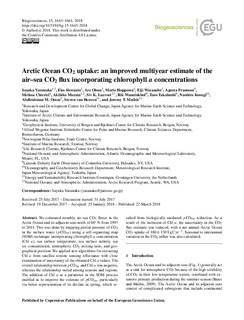Arctic Ocean CO2 uptake: An improved multiyear estimate of the air-sea CO2 flux incorporating chlorophyll a concentrations
Yasunaka, Sayaka; Siswanto, Eko; Olsen, Are; Hoppema, Mario; Watanabe, Eiji; Fransson, Agneta Ingrid; Chierici, Melissa; Murata, Akihiko; Lauvset, Siv Kari; Wanninkhof, Rik; Takahashi, Taro; Kosugi, Naohiro; Omar, Abdirahman; van Heuven, Steven; Mathis, Jeremy T.
Journal article, Peer reviewed
Published version
Permanent lenke
http://hdl.handle.net/11250/2559871Utgivelsesdato
2018Metadata
Vis full innførselSamlinger
- Articles [3001]
- Publikasjoner fra CRIStin [3023]
Sammendrag
We estimated monthly air–sea CO2 fluxes in the Arctic Ocean and its adjacent seas north of 60° N from 1997 to 2014. This was done by mapping partial pressure of CO2 in the surface water (pCO2w) using a self-organizing map (SOM) technique incorporating chlorophyll a concentration (Chl a), sea surface temperature, sea surface salinity, sea ice concentration, atmospheric CO2 mixing ratio, and geographical position. We applied new algorithms for extracting Chl a from satellite remote sensing reflectance with close examination of uncertainty of the obtained Chl a values. The overall relationship between pCO2w and Chl a was negative, whereas the relationship varied among seasons and regions. The addition of Chl a as a parameter in the SOM process enabled us to improve the estimate of pCO2w, particularly via better representation of its decline in spring, which resulted from biologically mediated pCO2w reduction. As a result of the inclusion of Chl a, the uncertainty in the CO2 flux estimate was reduced, with a net annual Arctic Ocean CO2 uptake of 180 ± 130 Tg C yr−1. Seasonal to interannual variation in the CO2 influx was also calculated.
